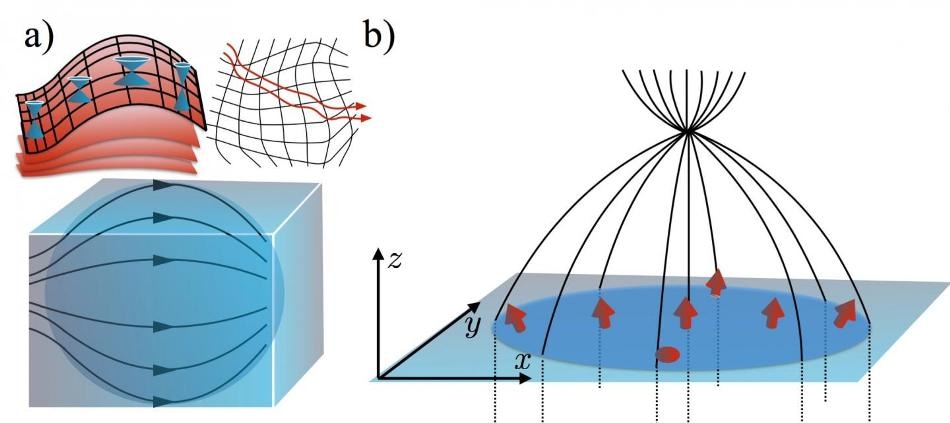Nov 8 2017
A team of researchers have demonstrated how the principles of general relativity pave the way for novel electronic applications such as electronic invisibility devices and a 3D electron lens. In a new study sponsored by the Academy of Finland, Aalto University researchers Alex Westström and Teemu Ojanen suggest a technique to surpass special relativity and mimic Einstein's theory of general relativity in inhomogeneous Weyl semimetals.
 Picture: a) By local manipulation of material parameters, it is possible to tune the properties of charge carriers in Weyl semimetals; b) With suitable local manipulation of material parameters, one can tailor the carrier motion and design novel electronic devices such as the electron lens, which focuses the incoming carriers. (CREDIT - Teemu Ojanen)
Picture: a) By local manipulation of material parameters, it is possible to tune the properties of charge carriers in Weyl semimetals; b) With suitable local manipulation of material parameters, one can tailor the carrier motion and design novel electronic devices such as the electron lens, which focuses the incoming carriers. (CREDIT - Teemu Ojanen)
The theory of Weyl metamaterials uses ideas from particle physics, solid-state physics, and cosmology and shows a way to create metallic designer materials where charge carriers travel like particles in curved space-time.
The researchers suggested the use of Weyl metamaterials, a type of Weyl semimetals, which use new types of electronic gadgets through geometric engineering.
The systems we introduced offer a route to make the charge carriers move as if they were living in a curved geometry, providing a tabletop laboratory for simulating curved-space quantum physics and certain cosmological phenomena.
Alex Westström, Academy of Finland, Aalto University researcher
Weyl semimetals are an example of newly discovered quantum materials that have gained a lot of interest. Charge carriers in these materials act as if they were massless particles traveling at the speed of light.
"We discovered that Weyl metamaterials may serve as a platform for exotic electronic devices such as the 3D electron lens, where the trajectories of charge carriers are focused much like beams of light in an optical lens," Teemu Ojanen says.
The electric conduction in Weyl semimetals reflects the physics of Einstein's theory of special relativity. However, special relativity also assumes a nonexistence of gravity, which Einstein expressed as a geometry of space-time.
The theory of Weyl metamaterials also opens the door to brand new electronic applications, for example, the creation of electronic invisibility devices. The leading idea behind the potential applications is an artificially formed curved geometry, which bends the motion of charge carriers in an controlled way.
In optics, it's been known for centuries that light always chooses the quickest trajectory. In curved geometry, the quickest path doesn't look like a straight line for those watching from outside. The functionality of optical invisibility devices, where the beams of light bypass a hidden object, is in fact based on the application of curved-space geometry. It would be a breakthrough in fundamental research to achieve a similar functionality in electronic systems.
Teemu Ojanen, Academy of Finland, Aalto University researcher